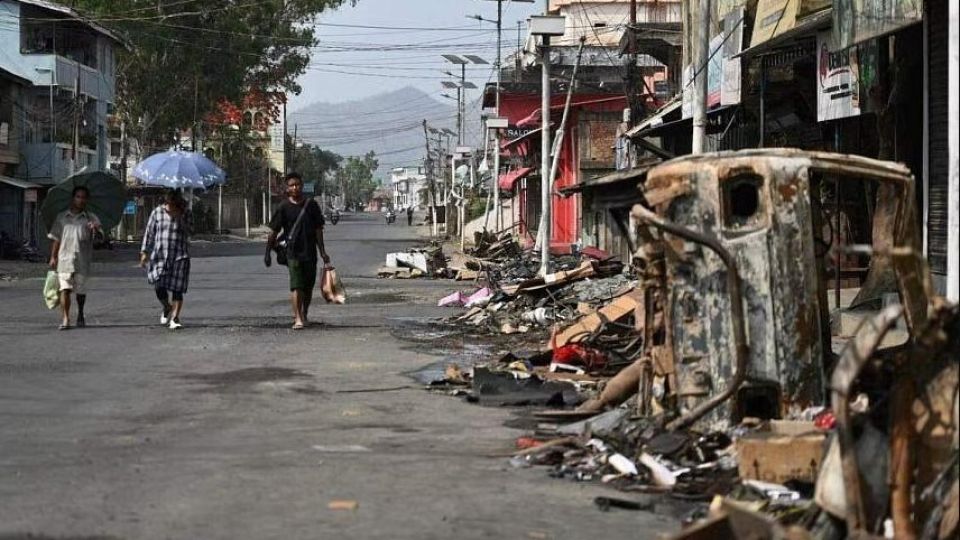May 12, 2023
NEW DELHI – Residents in the north-eastern Indian state of Manipur are beginning to pick up the pieces, after some of the worst ethnic violence in recent decades, which has left more than 60 dead and as many as 35,000 people displaced.
Thousands who evacuated after clashes erupted on May 3 between the majority Meiteis and Kuki hill tribe are slowly returning home under security escort. With violence ebbing, a curfew has also been eased in most of the state, allowing locals to purchase essentials from markets.
Yet, the road to normalcy in Manipur is a long one as mutual distrust continues to prevail, compelling many to stay away from their homes in fear of a resurgence in the fighting.
The airport in Manipur’s capital Imphal has become a temporary shelter for around 100 people waiting to catch a flight out. Among them is 34-year-old Florence Chingboo, a Kuki government employee based in the Imphal valley. Waiting at the airport with her son, who is yet to turn three, her husband and their parents, she told online publication The Print that they “do not want to take a chance”.
Experts say Prime Minister Narendra Modi’s Bharatiya Janata Party (BJP), which governs the state, now faces an uphill task of rebuilding trust among the ethnic groups and restoring long-term stability to a region that shares a 398km border with Myanmar, and is on the front line of India’s strategic engagement with South-east Asia.
Violence erupted last week after the Kuki tribe and other hill communities held a rally to protest against the Meitei’s demand for “Scheduled Tribe” status. This would give the Meiteis benefits that the hill tribes enjoy under this status, including reserved quotas for government jobs and college admissions. Such a classification for the Meiteis would also allow them to own land in their hills.
The Meitei community, who make up 53 per cent of the state’s 3.2 million population, is mostly confined to the valley districts that form around 10 per cent of Manipur’s area. Less than 40 per cent of Manipur’s people inhabit the hilly terrain that covers 90 per cent of the state.
Non-tribals, including the Meitei, cannot buy and own land in the hill areas, a move aimed at protecting marginalised tribal communities. There is no such restriction on tribals buying land in the valley.
This grouse, together with the rising population in the valley and inadequate economic opportunities, are driving the Meiteis’ demand for Scheduled Tribe status.
The Kukis and other hill tribes worry that the Meiteis, who are politically and economically more influential, could acquire greater control over their ancestral forest land and its resources.
Such concerns have been aggravated by recent government actions to drive out hill tribes from protected forest areas, along with a campaign to stop illegal poppy cultivation, which poor hill villagers resort to for extra income.
Added to this potent mix are allegations of illegal immigration from Myanmar. Manipur Chief Minister N. Biren Singh claimed in May that Myanmar immigrants are responsible for deforestation, poppy cultivation and a drug menace in the state.
Myanmar refugees belong to the same ethnic group as the Kukis and other hill tribes in the region. Broad-brush attacks have targeted all Kukis as “immigrants” and “foreigners”, deepening tensions.

Thousands who evacuated after clashes erupted on May 3 between the majority Meiteis and Kuki hill tribe are slowly returning home under security escort. PHOTO: AFP
The primarily ethnic conflict has also taken on religious overtones, with churches and temples vandalised in the violence. Meiteis are mostly Hindus, and the Kukis predominantly Christian.
Professor Kham Khan Suan Hausing, who teaches political science at the University of Hyderabad, said the state government must take responsibility for failures that led to the violence.
“We have seen an institutionalised riot system,” he told The Straits Times, referring to allegations that the police targeted tribal protesters in the recent clashes. “This is a concern that must be acknowledged and addressed, because the wounds and hate are already quite extensive.”
The government, he added, must also realise the “value of accommodation” and respect the “inviolability” of local institutions that are meant to protect tribal land rights.
The violence has undercut the BJP’s attempt to restore peace and stability in the north-east, and lay the groundwork to further India’s Act East Policy and promote greater cooperation with the Asia-Pacific region.
Two roads which connect India with Myanmar pass through areas dominated by Manipur’s hill tribes.
Professor Rajen Singh Laishram, head of the political science department at Manipur University, said these roads remain vulnerable to closures due to violence, as seen recently, undermining India’s Act East Policy.
“We need to present an image of a dependable partner,” he told ST.
Delegations from Myanmar and Thailand have often complained about insurgency and extortion along these roads as a deterrent to greater connectivity and trading links with Manipur, added Professor Laishram, who focuses on South-east Asia in his research.
“The recent violence does not help at all, as it portrays a negative image of Manipur to other parts of South-east Asia.”


